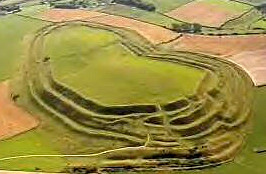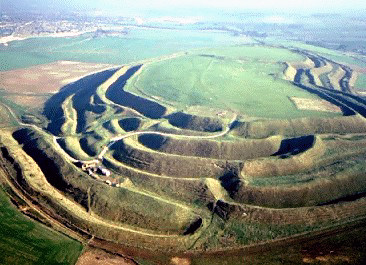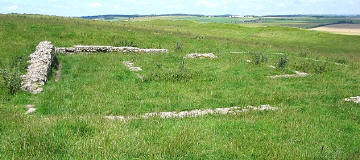Maiden Castle
near Dorchester, Dorset
  |
Maiden
Castle is the largest Iron Age hill fort in Europe and covers an area of 47
acres, a large area, equivalent to 50 football pitches. 'Maiden' derives from the Celtic 'Mai Dun' which means 'great hill'. It
is situated just 2 miles south of Dorchester
in Dorset. The earthworks are immense, some ramparts rising to a height of
6 metres (20 feet) today, they have previously been even higher. |
Its early development of Maiden Castle began around 3000BC and flint
tools and other objects from that time have been found. At this time it was a
far simpler structure. The late Stone
Age/early Bronze Age people who lived there built a massive ditch and bank some
545 metres in length. There are Bronze Age burial mounds on the right hand end
of the Castle.
|
The
present hill fort, as we see it today, was developed during the Iron Age around 450-300BC when the area of the fort was extended and the ramparts and ditches
were enlarged. Three ditches were dug, the earth removed and used to build the
ramparts. A wooden fence would have been built along the ramparts with wooden
gates at the entrances. The entrances were not aligned therefore making it more
difficult for opposing forces to gain entry.
At the
time of the Roman invasion in 43AD, Maiden Castle was inhabited by the Durotriges tribe. The battle to take the castle was a bloody one: the Romans
under Vespasian finally took it. Recent excavations have uncovered the bodies
of 38 Iron Age warriors, buried with food and drink for their journey into the
after life.
|
  |
|
As was common, the Romans
developed a new settlement nearby, in this case Dorchester, the roman name was Durnovaria,
meaning 'place with fist-sized pebbles'. |
|
 
See here for Picture Details |
The local celtic tribe the
Durotriges, were a confederation of tribes, and its thought they had two capitals,
this was one the other was at nearby Ilchester, the Romans developed Ilchecter,
calling it Lindinis, the hill forts nearby are Cadbury Castle and Ham Hill. This
time frame has a shifting map of tribes and differences both between historical
version and times, so maps of areas held by different tribes don't line up that
well. Cadbury Castle was thought to be a part of another kingdom,
while most references to Ham Hill usually mention the Durotrges. Ilchester
is about mid way, and some way from each, and the Romans may have decided to
have a single settlement, combining two areas. There are quite a lot of other
small hill forts like Ham Hill, around the area, it does not look like a
significant place.
|
A Roman
temple was built at Maiden Castle in the 4th century, the foundations
can be seen today. The fort was abandoned shortly after this time, although it
may have been occupied during early Saxon times. It has not been used since that
time.
There does not appear to have
been any later fortification, as in the case of Cadbury Castle, so its not a
contender for being a major place in the period of King Arthur. While
later Old Sarum was reinforced and far later had stone buildings, Maiden castle
was not.
The site is not covered in forestry so you can
get a better idea of how a major hill fort would have looked, than with many
other sites.
 See here for Picture Details
See here for Picture Details
Maiden Castle is maintained by
English Heritage and is open all year. At the site there is a large car
park with information boards regarding its history.
Planning Grid
|
Location: |
Maiden Castle, near
Dorchester, Dorset |
|
Grid Reference |
SY 669884 |
|
Map Link: |
Multimap
Google Maps Aerial photograph (you can drag around area, and zoom in and
out to see more detail). |
|
Getting there: |
2 miles south of
Dorchester, off the
A354 |
|
Access: |
Short but steep trail to the right of the car
park, which leads you through the original Iron Age entrance to the hill
fort. Another trail takes you across the hill fort defences and involves
some steps. |
|
Parking: |
The car park at Maiden Castle is at the end of
Maiden Castle Road in Dorchester. This comes off Weymouth Road, on the left
going into Dorchester from the A35 from the south. It crosses the A35,
but you have no entrance to it from the A35. |
|
Facilities: |
Downloadable MP3 audio
tour for Maiden Castle from
http://www.english-heritage.org.uk/server/show/nav.17836 |
|
Things To Do,
See and Photograph: |
Hill fort, impressive entrance. |
|
What to take: |
|
|
Nature highlights: |
|
|
Best Times to
Visit: |
|
|
Address: |
|
|
Postcode: |
|
|
Telephone: |
|
|
E-mail: |
|
|
Website: |
http://www.english-heritage.org.uk/server/show/nav.15733
6000 years of history at
http://www.english-heritage.org.uk/server/show/nav.17828 |
|
Opening times: |
Open all the time |
|
Charges: |
None |
|
Photo Restrictions: |
None |
|
Other Restrictions: |
None |
|
Special Needs Access: |
Difficult, steep climb, good walkers only |
|
Special Needs Facilities: |
None |
|
Children Facilities: |
None |
|
Dogs Allowed: |
No known restrictions. |
|
Other useful
websites: |
http://www.historic-uk.com/DestinationsUK/MaidenCastle.htm |
|
CIN Page Ref: |
maiden_castle |
Date Updated:03/08 |
Please let us know any other information that we
can add to this Planning Grid or page and any errors that you discover. Before making a long trip to any location it is always
wise to double check the current information, websites like magazines may be
correct at the time the information is written, but things change and it is of
course impossible to double check all entries on a regular basis. If you have
any good photographs that you feel would improve the illustration of this page
then please let us have copies. In referring to this page it is helpful if you
quote the CIN Page Ref at the bottom of the Planning Grid above. To print the
planning grid select it then right click and print the selected area.
Please submit information on locations you discover so
that this system continues to grow.
|